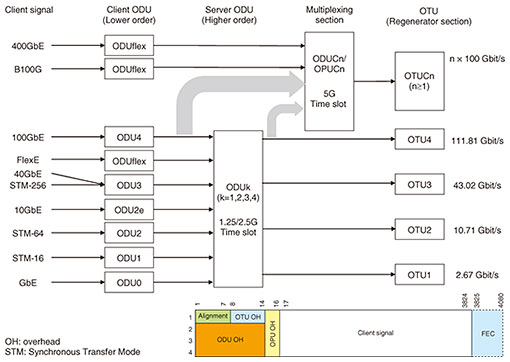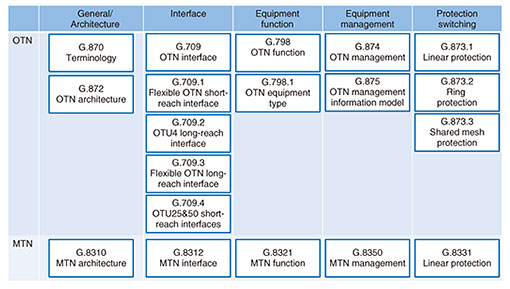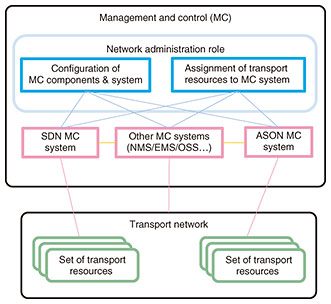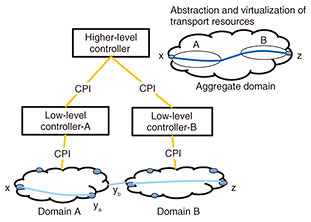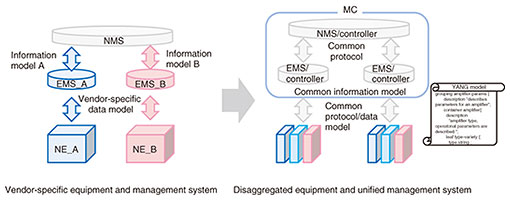 |
|||||||||||
|
|
|||||||||||
|
Global Standardization Activities Vol. 20, No. 6, pp. 43–51, June 2022. https://doi.org/10.53829/ntr202206gls Optical Network Technology for Future Ultra-high-capacity Communications in the Beyond 5G and Big Data EraAbstractThe optical network is key to the ultra-high-capacity and highly reliable communications infrastructure for addressing the demand of rapidly increasing traffic and diversified services, which will be manifested with further development of 5G (fifth-generation) and beyond mobile communication services and applications including Internet of things, high-definition video, big-data analysis, and artificial intelligence. This article gives an overview and recent trends in standardization of optical network technology, mainly focusing on the ITU-T (International Telecommunication Union, Telecommunication Standardization Sector) Study Group 15. Keywords: optical network, standardization, ITU-T 1. Overview of standardization of optical network technologyThe International Telecommunication Union (ITU) is one of the organizations of the United Nations that covers all member states including developed and developing countries and responsible for information and communication technology (ICT) matters. ITU Telecommunication Standardization Sector (ITU-T) is the sector responsible for international de jure standardization of the ICT infrastructure in ITU, while two other sectors, ITU-R (Radiocommunication Sector) and ITU-D (Telecommunication Development Sector), are responsible for radio-communication and telecommunication development, respectively. ITU-T consists of 11 Study Groups (SGs), and SG15 covers a wide area of technology relating to a very basic communications infrastructure of ICT services. ITU-T SG15 consists of 13 Questions, as shown in Fig. 1, and investigates all network areas including home, access, metro, and core, and various technical fields including optical physical infrastructures, optical and metallic cables, passive optical network (PON), optical wavelength-division multiplexing (WDM), time-division multiplexing (TDM), packet transport, network, synchronization, architecture, and management and control of the network.
Although ITU-T SG15 is the leading organization in optical network standardization, it has been common in international standardization that progress is not made with only an entity but collaborations among many standardization bodies. Figure 2 classifies international and internal Japan organizations relevant to optical network standardization concerning each network layer.
At the physical media layer called layer 0, ITU-T SG15 collaborates with the International Electrotechnical Commission (IEC) Technical Committee (TC) 86 (fiber optics) in the field of optical components, optical fibers and cables, and physical infrastructures. While ITU-T SG15 basically focuses on telecom networks, IEC TC 86 covers more generic application areas including industries and vehicles, and many manufacturers worldwide participate to discuss detailed specifications and test methods. The Optical Internetworking Forum (OIF) mainly involves optical components and module manufacturers and develops multi-source agreements (MSAs), which are interoperable implementation specifications provided for industries. At layer 1, which is supported by TDM technology, synchronous digital hierarchy (SDH) was conventionally used when telephone-based services were mainstream. The optical transport network (OTN) was then developed for data-centric services, and its standardization is basically discussed only in ITU-T SG15. At layer 2, which is based on packet transport technology, the Institute of Electrical and Electronics Engineers (IEEE) 802.3 develops Ethernet standards, and the Internet Engineering Task Force (IETF) specifies Internet Protocol/Multi-Protocol Label Switching (IP/MPLS). ITU-T SG15 modifies their basic structures to add functions necessary for highly reliable and operational telecom network services, including enhanced operations, administration, and maintenance (OAM) and protection, to create carrier-grade Ethernet and the MPLS Transport Profile (MPLS-TP) [1]. For precision time distribution over packet networks, ITU-T SG15 standardizes specifications on the basis of IEEE 1588 from the aspects of telecom network operation. It also collaborates with the 3rd Generation Partnership Project (3GPP) on specifications for recent fifth-generation (5G) or beyond 5G mobile services [2]. In terms of overall network architecture, atomic function models are used to describe network configurations and behavior of signal accommodation and transport. For management and control of network equipment, information models based on Unified Modeling Language are developed in collaboration with Open Networking Foundation (ONF); data models, which depend on protocols, are based on Yet Another Next Generation (YANG) model description mainly developed in IETF. There are also collaborations with relevant standardization bodies, including TM Forum, Metro Ethernet Forum (MEF), and Broadband Forum (BBF), through liaisons and joint meetings. Since ITU-T and IEC are de jure standardization organizations participated by member states and responsible for standards obliged by the WTO (World Trade Organization) Agreement on Technical Barriers to Trade, standards committees were established in the Telecommunication Technology Committee (TTC) and Institute of Electronics, Information and Communication Engineers (IEICE) for internal discussions in Japan. 2. Access and home networkThe PON is the main transport technology in the access network area, and various specifications have been standardized, such as B-PON (Broadband PON), G-PON (Gigabit-capable PON), XG-PON (10 Gigabit-capable PON), and 40G-PON (40 Gigabit-capable PON), which is based on time- and wavelength-division multiplexing in the upstream and downstream directions using 10-Gbit/s high-speed channels per wavelength. They are standardized as ITU-T Recommendations G.983.x, G.984.x, G.987.x, and G.989.x, respectively. Recent discussions include higher-speed PONs based on 25 or 50 Gbit/s, WDM-PONs for further increase in fixed capacity using multiple wavelengths, and Super-PONs (named in IEEE) to extend reaches to over 50 km with 64 branches. There are also discussions addressing mobile services, including radio-over-fiber for efficient mobile signal transmission, dynamic bandwidth allocation for lower latency, and PON slice networks for flexible services. While optical access technology has prevailed worldwide, there is still demand for asymmetric digital subscriber line/very high-speed digital subscriber line (ADSL/VDSL) technology using metallic media, such as coaxial cables and telephone lines. Thus, G.fast, which enables high-speed metallic cable transmission ranging from 100 Mbit/s to 1 Gbit/s, has been standardized, and G.mgfast is currently being discussed for higher speeds of several gigabits per second. For home networks, G.hn series Recommendations have been developed for transceivers that transmit signals over metallic media using frequency bandwidths at around hundreds of megahertz and are mainly applied for high-quality video and smart grid services. Visible light communications are also discussed for services at speeds of hundreds of megabits per second over the range of several meters. 3. Optical physical infrastructure, fiber cables, and WDM systemThe physical infrastructure that protects network resources in various environments is significant for stable network operation. ITU-T SG15 mainly standardizes operation and maintenance issues, measurement methods including cable identification, and specifications of terminal boxes and closures installed in outdoor environments for optical-fiber distribution and connection. For further detailed specifications, such as mechanical characteristics, dust and water resistance, and robustness against temperature and humidity change, IEC TC 86 mainly investigates and standardizes them. Optical-fiber and cable characteristics and their test methods have been standardized as G.65x series Recommendations: G.652 for basic single-mode fibers, G.653 for dispersion-shifted fibers, G.654 for cut-off shifted fibers, and G.655 for non-zero dispersion-shifted fibers. For future higher-capacity signal transmission, discussions on space-division multiplexing using multi-mode or multi-core fibers have recently started. The progress of WDM transmission technology is key to achieve a very large capacity optical network, and various fundamental parameters have been specified for high performance and stable operation, including signal wavelength allocation, optical transmission bandwidth, signal bit rate per wavelength, modulation and demodulation schemes, and transmitter (TX) and receiver (RX) optical power level [3]. G.698.x series Recommendations define interoperable interfaces at single-channel connection points between TX, RX, and an optical link that includes optical fibers, amplifiers, and multiplexers/demultiplexers (MUX/DEMUX), as shown in Fig. 3. The parameters for TX and RX are set at reference points SS and RS without specifying the detailed configuration inside the optical link, which is called a black link approach. The optical signal emitted at the TX is specified by various parameters, some of which degrade during propagation in the optical link: decrease in the optical signal-to-noise ratio (SNR) due to optical amplifier noise accumulation, inter-channel crosstalk in MUX/DEMUX, waveform distortion due to fiber chromatic dispersion and nonlinearity, and polarization-dependent differential group delay or polarization mode dispersion. After transmission, signal parameters including minimum optical power and SNR must satisfy the specifications defined for the RX.
G.698.2 is intended for an optically amplified WDM system typically applied to a metro area, which transmits 10 to 100 Gbit/s per-channel signals over several hundred kilometers. Further discussions on G.698.2 address capacity increase by applying higher-speed signals from 200 to 400 Gbit/s per channel. There is also discussion on a low-cost WDM system that transmits 25 Gbit/s signal per channel over 10 to 20 km for mobile front-haul applications. For submarine cable systems, Recommendation G.977.1 has been standardized in view of recent demand for transverse compatibility between terrestrial terminal equipment and submerged plant consisting of optical-fiber cables and amplifiers, on conditions that they are installed by different manufactures. Discussions on new submarine-cable-system applications have recently started for scientific remote undersea sensing, which is relevant to the joint task force on SMART (Science Monitoring and Reliable Telecommunications) cable systems between ITU, World Meteorological Organization, the United Nations Educational, Scientific and Cultural Organization, and Intergovernmental Oceanographic Commission. 4. TDM systemThe OTN can efficiently accommodate and multiplex various types of client signals in time division, and transmit them over long distances. OTN interfaces are specified in Recommendation G.709 including the OTN frame structure and multiplex hierarchy shown in Fig. 4. A client signal is contained in a container called an optical channel data unit (ODU) with additional overhead bytes for management and control then hierarchically multiplexed to compose a higher-order ODU. Finally, an optical channel transport unit (OTU) frame consisting of 4 rows by 4080 columns is created after adding Reed-Solomon (255,239) forward error correction (FEC) for transmission through an optical WDM system. The frame length of SDH, which was a core technology when telephone-based services were dominant, was fixed at 128 μs independent of the signal bit rate to send each byte repeatedly at 8 kHz. The OTN frame structure is fixed, and its size changes depending on the signal bit rate. The ODU size is defined to accommodate not only SDH but also various client signals including Ethernet. The G.709.x series Recommendations have been successively standardized to flexibly accommodate higher-speed client signals over 100 Gbit/s. Flexible OTN, defined in G.709.1 and G.709.3 for short and long reach, respectively, transmits the signal over multiple wavelengths and uses a different ODU frame structure from the conventional OTN, which is 128 rows by 5140 columns. G.709.3 adopts higher-performance FEC depending on the signal bit rate and distance, such as staircase FEC or oFEC, which is determined by the Open ROADM MSA. Discussions on beyond 400G OTN have started to transmit the next generation higher-speed Ethernet over 400G, that is, 800 Gbit/s or 1.6 Tbit/s, discussed in IEEE.
For mobile signal transmission, a series of Recommendations for the metro transport network (MTN) has been standardized, which is engaged in transmitting the radio-access network traffic connecting distribution units and central units in the IMT (International Mobile Telecommunications)-2020/5G mobile front or middle haul. The MTN is based on FlexE, which has a TDM process between the media access control (MAC) and physical coding sublayer layers and can transmit Ethernet with a flexible granularity by using multiple physical interfaces. FlexE is originally specified in OIF, and the MTN is created by adding OAM functions necessary for highly reliable telecom network operation, including path and error monitoring, connectivity verification, delay measurement, and protection. The client signal in an MTN path has a 64B/66B Ethernet MAC frame and is processed at a unit of a 66B block. An MTN path is carried over 5-Gbit/s calendar slots in the MTN section layer. The structure of Recommendations relevant to the OTN and MTN includes architecture, interface, equipment function and management, and protection, as shown in Fig. 5 [4]. While pursuing higher-speed transmission, there is also a discussion on the OTN and MTN that accommodate lower-speed client signals below 1 Gbit/s. The discussion has started from clarification of the necessity of such an interface in view of actual service requirements because most low-speed circuit-based services can be covered by packet transport technology, and additional interfaces could significantly affect existing systems.
5. Packet transport systemITU-T SG15 has developed the carrier-grade Ethernet to achieve high reliability and operability necessary for telecom network operators as well as traditional circuit-based TDM technology, such as SDH, while taking advantage of high efficiency and cost effectiveness inherent in the packet transport technology. A series of Recommendations, G.80xx, have been standardized to include overall architecture, service requirements, interfaces, OAM, equipment functions and management, and protection, similar to OTN Recommendations [4]. The MPLS-TP uses basic MPLS data-forwarding mechanisms but adds enhancements for high reliability and maintenance capability achieved in TDM-based systems while excluding functions in MPLS that may preclude carrier-grade network operation. The management of a connection-oriented path between the two end points is difficult with penultimate hop popping, equal-cost multipath, and label merging because of a lack of full traceability of the path; OAM packets must pass through the same path as the signal packets to accurately monitor the condition of the path. Another significant point is the separation between the control plane and data plane; a conventional MPLS network may disconnect user data traffic in the case of control-plane failure but this is not allowable in carrier-grade network operation. A series of Recommendations, G.811xx, have been standardized for MPLS-TP based packet networking [4]. Most basic standards for packet transport technology have been completed in ITU-T SG15, and current discussions mainly focus on equipment information and data models and text modifications in accordance with developments in IEEE discussions. 6. Architecture and management/controlThe automatically switched optical network (ASON) was originally standardized as G.8080 before the emergence of software-defined networking (SDN). The structure of relevant standards was then reviewed and a concept of management control (MC) systems was introduced, which includes discrete management and control functions including an element management system (EMS), network management system (NMS), and operation support system (OSS) with SDN and ASON, as shown in Fig. 6. The “Configuration of MC components and system” function instantiates an MC system and its MC components, and the “Assignment of transport resources to MC system” function assigns transport resources. Other MC systems include transport-resource management functions and FCAPS (fault, configuration, accounting, performance and security). The transport resources are partitioned and assigned to a specific MC system to be configured by only the MC system. The Recommendations for transport SDN and ASON are rebuilt as G.7702 and G.7703, respectively, and common control aspects are described in G.7701.
The architecture for transport SDN is designed to provide multi-dimensional heterogeneity for optimizing the network and services in terms of infrastructure granularity, capacity-adjustment flexibility, survivability, and infrastructure evolution. It has multiple hierarchical controllers that can be connected to each other through control plane interfaces (CPIs), as shown in Fig. 7, and an SDN controller supports one or more clients to establish a client/server relationship. An SDN controller has both local resources and resources provided by one or more server SDN controllers, including the transport resources and MC components, and transport resources are assigned to a virtual network in a client controller; the server SDN controller presents a virtualized view of the transport resources to the client SDN controller. Thus, the architecture enables centralized management and control of connections, network abstraction, and route optimization over different domains. New discussions have started to use artificial intelligence or machine leaning for advanced root cause analysis applicable for a complicated failure case; discussions will include MC architecture, interfaces, and the relationship with current MC components.
The structure of Recommendations for network management consists of generic standards that are independent of specific technology and protocols, and technology-specific standards addressed to the OTN, Ethernet, and MPLS-TP. Figure 8 shows an evolution of network control and management and equipment configuration. While a traditional approach depends on the vendor-specific EMS and equipment, a future approach is expected that would consist of disaggregated equipment and unified control and management to avoid vendor lock-in and reduce procurement cost.
In the short term, an approach will be promising that uses a vendor-specific EMS/controller and unifies end-to-end paths by NMS. A common EMS/controller will then achieve unified control and management. To this end, standardization of common management information models and data models of equipment, network, and protocols are being discussed. Information models are generally conceptual, protocol independent, and abstracted from implementation and services, while data models are specific, protocol dependent, and abstracted from detailed equipment components. ITU-T SG15 has standardized G.7711, a common information model that is independent of specific equipment, control, and protocol. Technology-specific information models have also been standardized as G.875, G.8052, and G.8152 for the OTN, Ethernet, and MPLS-TP, respectively. Further discussions include generation of a protocol-specific data model by using conversion tools. ONF discusses information models, interfaces, implementation, and interoperability on the basis of CORD (Central Office Re-architected as a Datacenter), ONOS (Open Network Operating System) controller, and OpenFlow protocols. IETF proceeds with internet drafts that specify conversion methods of information models developed in ITU-T and ONF to YANG models. 7. ConclusionThe significance of further development and standardization of ultra-high-capacity optical network technology is being emphasized because of rapidly increasing traffic and diversified services envisaged in the coming beyond 5G and big data era. Creating common specifications by international standardization is expected to essentially reduce cost and development time and stimulate the market. We will proactively contribute to developing optimum optical network technology standards toward the implementation of IOWN (the Innovative Optical and Wireless Network) [5] in view of international service requirements and leading-edge technology development. References
|
|||||||||||












